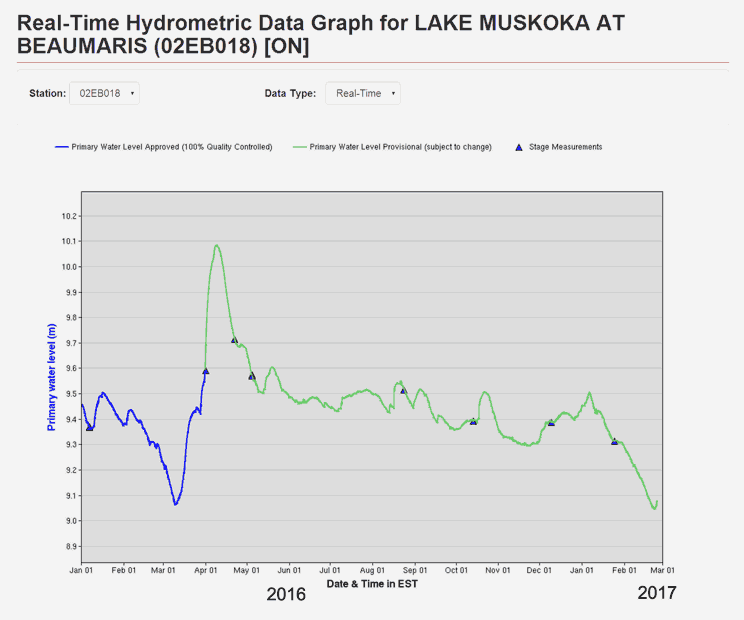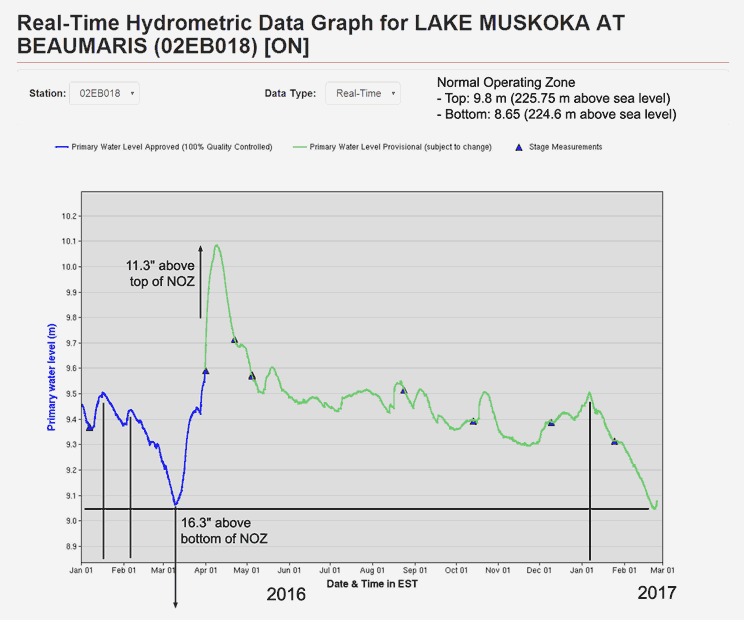Through Environment Canada, the federal government provides water level information to the public, including for Lake Muskoka.
The Muskoka River Water Management Plan (MRWMP) specifies the Normal Operating Zone (NOZ) for all major waterbodies in the Muskoka River’s watershed. Water levels above the NOZ can cause flooding and water levels below the NOZ can cause problems such as boats hitting rocks.
In the weeks and months in advance of the spring freshet, the Ministry of Natural Resources and Forestry (MNRF) removes stop-logs from their dams to draw down the water level as allowed by the MRWMP with the intention that once the snow and ice melt, water levels will not rise above the NOZ. As described in this article and presented in this graphic, both from last year, in 2013 and 2016 there was significant flooding of Lake Muskoka, and in those years, the MNRF could have drawn-down the water levels in advance much more than they did.
So here we are, it is February 25, 2017, there is snow on the frozen ground, temperatures often above freezing, and rain, all of which contribute to rising water levels. Let’s look at the current situation compared to last year.
The above graph is from Environment Canada’s web site, showing the water level of Lake Muskoka for the 14 months from January 1, 2016 to February 24, 2017 (click on it for a larger view). So far, it appears that the situation is about the same as last year – that the MNRF has not drawn-down the water level as much as they could. This could be due to there being less snow on the ground than this time last year so the MNRF does not expect that the Lake Muskoka water level needs to be drawn-down further.
As shown below, some lines and and additional information have been added to this graph.
The above graph shows that:
- The NOZ for Lake Muskoka is between 224.6 and 225.75 metres above sea level, which corresponds to 8.65 to 9.8 m as shown in this graph (click on it for a larger view).
- Last year, the MNRF began drawing-down the Lake Muskoka water level in mid-January 2016, and was more successful at this after the first week of February 2016. The minimum water level was before mid-March and was 9.06 m on this graph, which was still 16.3″ higher than the bottom of the NOZ (that is, the MRWMP allowed the MNRF to lower the Lake Muskoka water level by 16.3″ more than they did last year).
- The peak of the 2016 spring freshet was in early April 2016, when the maximum water level was 10.08 m. This is 11.3″ above the NOZ and was the cause of much flooding and damage.
- This year the MNRF began the draw-down slightly sooner, about the first week of January 2017 and the minimum water level so far (on February 23, 2017) is very slightly lower than last year (by less than an inch). As for last year, the MNRF could have started the draw-down sooner, or done it more rapidly as the MRWMP allows the water level to be drawn-down by 16″ more than they have so far.
Observations:
- So far the MNRF has drawn-down the water level of Lake Muskoka about the same as last year.
- If the proposed hydro-electric generating station was built at the Bala falls, the water level of Lake Muskoka would be controlled by the developer, and the developer would receive a financial incentive for keeping water levels as high as possible. For example, if the Lake Muskoka water level was 5% higher (compared to the Moon River), then the developer would receive 5% more for the additional power generated. Since most all of their costs would be fixed (construction financing debt, operation staff, insurance, maintenance …), this would result in much higher profits. And if these intentional higher water levels cause flooding, the developer could always blame it on the weather, as the MNRF already does.


Just think of all the insurance claims going through but the funny thing is that not a lot of insurance companies include flooding unless you have specifically paid into that.